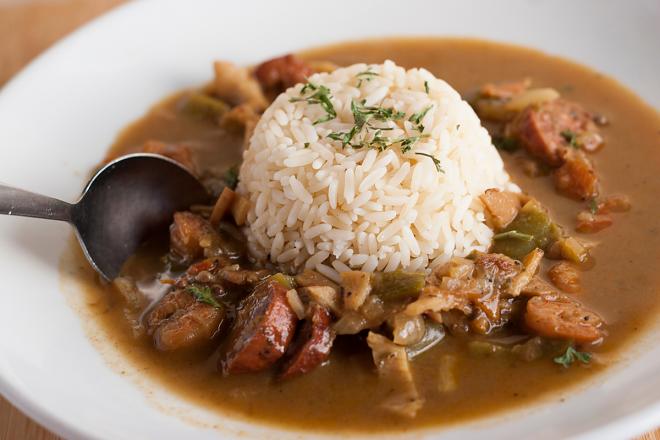Subscribe!
Sign up for Latest News, Upcoming Events and Builder Incentives!

On Nov. 12, local gumbo krewes will get competitive for a good cause during the annual Gumbo Cook-Off at Cross Creek Ranch. Is there really a difference in gumbo? We assure you there is. No two gumbo recipes are alike; however, they all share some basics. Get them right and you have the foundation for a great gumbo. Here are some tips for ensuring people keep filling up their bowls.
First You Make a Roux
The base of all good gumbo is a good roux. A roux is flour browned in fat that adds flavor and thickens your gumbo. It sounds easy but getting it right — without burning it — can be a nerve-wracking business. The fat you should use — and the color of the finished roux — is the subject of fierce debate among gumbo aficionados. Fat choices come down to butter or oil. Butter adds a nutty flavor to the gumbo but has a lower smoke point so it’s easy to burn your roux. Using butter results in a lighter-colored roux. Since most people agree the roux should be the color of milk chocolate, a neutral oil is usually the preferred choice. Stir constantly to develop a deep color with burning. If you see brown flecks in your roux, it’s burned, and you must start over.
The Holy Trinity
Gumbo hails from Cajun and Creole country where the Holy Trinity reigns supreme. The Trinity is simply chopped onions, bell peppers and celery. Believe it or not, this is also a source of debate. From a purist standpoint, you should use green bell peppers and yellow onions. You can use red peppers and white or red onions for a different flavor. Some chefs swear by that combination. There seems to be no debate about the celery.
Stock Questions
Experts agree that stock should be used instead of water but what kind? That depends on what type of gumbo you are making. If you are cooking up a pot of chicken and sausage gumbo, use chicken stock. If you are planning a seafood gumbo, use a stock made from shellfish. It’s okay to use boxed or canned stock, but committed chefs make their own.
Meat and Vegetables
Chicken, andouille sausage and shrimp are traditional ingredients. Seafood gumbo often includes crab and shrimp. Gumbo chefs do get creative and use turkey, ham hocks and even alligator. Most meats are added once the stock is bubbling. Shellfish should be added at the end of the cooking process, so it doesn’t get rubbery. You can add any vegetables you like to add complexity to your gumbo. Corn and tomatoes add a summery vibe. Greens such as kale, chard or mustard greens are traditional in some gumbos. You can go non-traditional with squash or green beans. It’s really up to you.
To Okra or Not to Okra
Contrary to popular belief, okra is not a gumbo staple. It is primarily used as a thickener. If you want to use it, add it to the pot during the last 30 minutes of cooking. This ensures it doesn’t get slimy and that it thickens the gumbo properly. If you don’t like the taste of okra, leave it out. You can add filé powder after the gumbo is served. Filé is ground sassafras leaves typically sprinkled over individual servings to thicken and season the gumbo.
Never Rush Your Gumbo
Great gumbo takes hours to develop its delicious flavors. Plan for it to simmer for at least three hours, skimming off any fat that rises to the surface. Some people swear by letting the finished gumbo sit for a day before reheating it and serving.
Talk to Other Gumbo Chefs
You can talk to other gumbo chefs at the Gumbo Cook-Off title, 1-5 p.m. Saturday, Nov. 12 at Cross Creek Ranch. Benefitting the Fulshear Police Foundation, the event takes place from 1 to 5 p.m. at the Cross Creek Ranch Welcome Center, 6450 Cross Creek Bend Lane. You’ll be able to sample a range of gumbos, get tips and vote on your favorite. While doing so you can enjoy live Zydeco music, live and silent auctions, food vendors, a petting zoo, fire trucks and police vehicles, and more. Admission is free.